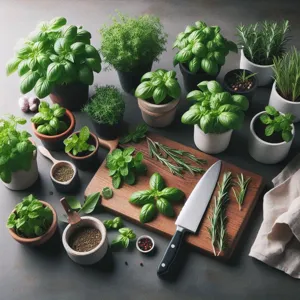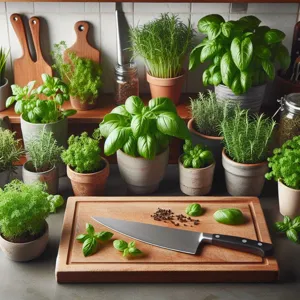Fresh herbs are nature’s little flavor bombs, capable of transforming even the simplest dish into a culinary masterpiece.
However, the clock is always ticking when it comes to their freshness, and it’s all too easy to let those vibrant bundles wilt and fade away before you can fully enjoy them. But fear not! In this post, we’ll explore some creative and practical ways to utilize those fragrant herbs before they go bad, ensuring that nothing goes to waste. From infusing oils and vinegars to crafting zesty pestos and aromatic herb salts, we’ll delve into a variety of innovative techniques that not only extend the life of your herbs but also elevate your cooking to new heights. Whether you’re a seasoned chef or a kitchen novice, these tips will inspire you to embrace the bounty of fresh herbs and add a burst of flavor to your meals. Let’s dive in and make the most of those green treasures before they slip away!
1. Introduction: The Importance of Using Fresh Herbs

Fresh herbs are more than just a garnish; they are nature’s culinary magic that can elevate your dishes from ordinary to extraordinary. In an age where farm-to-table dining is celebrated, using fresh herbs not only enhances flavors but also adds a vibrant touch to your meals, making them visually appealing and nutritionally rich. Herbs like basil, cilantro, rosemary, and mint are packed with essential oils and antioxidants, offering health benefits that go beyond flavor enhancement.
Using fresh herbs also connects you to the essence of cooking, allowing you to explore different cuisines and flavor profiles. Imagine the aromatic scent of freshly chopped thyme as you sauté vegetables, or the refreshing burst of basil infusing a summer pasta dish. These herbs deserve to shine in your kitchen, yet many of us struggle to use them before they wilt and lose their potency.
In this blog post, we’ll explore innovative and practical ways to incorporate fresh herbs into your cooking before they spoil. Whether you’re looking to make vibrant herb-infused oils, zesty sauces, or even unique herb-based desserts, the possibilities are endless. So, let’s dive into the world of fresh herbs and discover how to make the most of these green treasures!
2. Understanding Herb Shelf Life: How Long Do They Last?
When it comes to fresh herbs, understanding their shelf life is crucial to making the most of these vibrant ingredients before they wilt away. Fresh herbs are a delightful addition to any dish, adding layers of flavor and a burst of color. However, each type of herb has its unique longevity. Generally, leafy herbs such as basil, cilantro, and parsley tend to last about one week when stored properly, while sturdier herbs like rosemary and thyme can remain fresh for two weeks or more.
The lifespan of fresh herbs is significantly influenced by how you store them. For instance, herbs with delicate leaves, such as basil and cilantro, thrive best when treated like cut flowers. Trim the stems and place them in a jar with water, covering the leaves with a plastic bag to create a mini greenhouse effect. This method can extend their freshness for several days. Conversely, hardier herbs can be stored in the refrigerator, wrapped in damp paper towels and placed in a sealed plastic bag to maintain moisture without causing sogginess.
It’s also essential to keep an eye out for signs of decay—yellowing leaves, slimy textures, or a pungent smell indicate that your herbs are past their prime. By understanding the specific shelf life of your herbs and applying the right storage techniques, you can maximize their freshness and flavor. This knowledge not only helps reduce waste but also ensures that you have a steady supply of aromatic herbs on hand for your culinary creations. With a little attention to detail, you can keep your herbs vibrant and ready to elevate your dishes, ensuring that they don’t go bad before you get a chance to enjoy them!
3. Creative Recipe Ideas for Using Fresh Herbs

When it comes to fresh herbs, the culinary possibilities are as vast as the herb garden itself. If you’ve ever found yourself staring at a bunch of vibrant basil, cilantro, or rosemary, unsure of how to use them before they wilt away, fear not! Here are some creative recipe ideas that will not only elevate your dishes but also ensure that no precious herb goes to waste.
**Herb-Infused Oils and Butters**
One of the simplest and most delicious ways to use fresh herbs is by making infused oils or butters. Blend a handful of herbs like parsley, thyme, or dill with olive oil or softened butter. These infused concoctions can be drizzled over roasted vegetables, used as a flavorful base for pasta, or spread on bread for a gourmet touch. Not only do they pack a punch of flavor, but they also add a beautiful, vibrant color to your dishes.
**Herb-Loaded Pesto**
While traditional pesto typically features basil, feel free to experiment with whatever herbs you have on hand. Blend fresh herbs like arugula, spinach, or even mint with nuts, garlic, Parmesan cheese, and olive oil for a unique twist on this classic sauce. Use it as a dressing for pasta, a spread on sandwiches, or a dip for fresh veggies. The endless variations mean you can customize it to your taste and make the most of your herb bounty.
**Flavorful Herb Salads**
Take your salads to the next level by incorporating a medley of fresh herbs. Mix together chopped mint, parsley, and cilantro with your favorite greens, and toss in some citrus juice and olive oil for a refreshing salad that bursts with flavor. Add ingredients like feta cheese, nuts, or fruits for an extra dimension. This vibrant salad not only looks gorgeous on the plate but also is a delightful way to enjoy the bright, fresh notes of herbs.
**Herb-Infused Soups and Stews**
Herbs can truly shine in warm dishes like soups and stews. Consider making a hearty vegetable soup, and as it simmers, toss in generous handfuls of thyme, rosemary, or bay leaves. The herbs will release their oils and flavors into the broth, creating a comforting and aromatic dish. Finish off the soup with a sprinkle of fresh herbs just before serving to enhance the flavor and add a touch of freshness.
**Herb-Enhanced Marinades**
Don’t underestimate the power of herbs in marinades. Combine fresh herbs with garlic, citrus juice, and your choice of oil to create a zesty marinade for meats, fish, or tofu. Let your protein soak in these flavors for a few hours before grilling or roasting, and enjoy a dish that is bursting with freshness and depth.
By incorporating these creative recipes, you can ensure that your fresh herbs remain a star ingredient in your kitchen rather than fading away in the back of the fridge. Embrace the culinary creativity that fresh herbs inspire, and transform them into delicious meals that celebrate their vibrant flavors!
4. Making Flavorful Herb-Infused Oils
Herb-infused oils are a delightful way to capture the vibrant flavors of fresh herbs while elevating your culinary creations. The process is simple but the results are nothing short of magical. start by selecting your favorite herbs—basil, rosemary, thyme, or even a zesty hint of cilantro—to create a unique blend that reflects your taste.
Begin by gently washing and drying your herbs to remove any moisture, which can lead to spoilage. Next, chop them roughly to release their essential oils and maximize flavor infusion. In a small saucepan, combine your chopped herbs with a neutral oil, such as olive or grapeseed oil. The ratio can vary, but a good rule of thumb is to use about one cup of oil for every one cup of chopped herbs.
Heat the mixture over low heat, allowing it to simmer gently for about 20 to 30 minutes. Be careful not to let the oil reach its smoking point; you want to infuse the flavors, not fry the herbs. As the herbs steep, the oil will take on a beautiful hue and rich aroma, filling your kitchen with a fragrant symphony.
Once infused, strain the oil through a fine mesh sieve or cheesecloth into a clean, sterilized bottle. This will remove the herb solids and leave you with a smooth, flavorful oil ready for use. Consider adding a pinch of salt, a few whole herbs for visual appeal, or even a slice of chili for a hint of heat before sealing the bottle.
These herb-infused oils can be used in a multitude of ways—drizzling over salads, finishing off roasted vegetables, or as a dipping oil for crusty bread. Not only do they enhance the flavor of your dishes, but they also provide a beautiful presentation, making your meals feel extra special. Plus, they’re a fantastic way to prevent your fresh herbs from going to waste, allowing you to savor their essence long after they’ve left your garden or market basket.
5. Crafting Homemade Herb Pesto

Crafting homemade herb pesto is not only a delicious way to utilize your fresh herbs but also an opportunity to indulge your culinary creativity. While basil is the classic choice for pesto, feel free to experiment with any herbs you have on hand—from vibrant parsley and peppery arugula to fragrant cilantro and mint. The beauty of pesto lies in its versatility; you can customize the flavor profile to suit your palate or complement whatever dish you’re preparing.
To start, gather your herbs, nuts (pine nuts, walnuts, or even roasted sunflower seeds work beautifully), garlic, and some good quality olive oil. A touch of Parmesan cheese adds richness, but for a vegan twist, you can substitute nutritional yeast. Simply toss everything into a food processor, pulse until finely chopped, and then gradually drizzle in the olive oil until you achieve your desired consistency—smooth or slightly chunky, it’s entirely up to you!
Once your herb pesto is ready, the possibilities are endless. Use it as a vibrant pasta sauce, spread it on a sandwich for a burst of flavor, or drizzle it over grilled vegetables and meats. You can also freeze any leftover pesto in ice cube trays for convenient portions that you can add to soups or stews later on. By crafting your own homemade herb pesto, you not only prevent your fresh herbs from going to waste but also elevate your meals with a fresh, homemade touch that store-bought versions simply can’t replicate. Embrace the green goodness and savor the rich, aromatic flavors of your culinary creations!
6. Freezing Fresh Herbs for Later Use
Freezing fresh herbs is an excellent way to preserve their vibrant flavors and aromas, ensuring that you can enjoy the essence of your garden long after the growing season has ended. This method not only extends the shelf life of your herbs but also captures their peak freshness, making them a fantastic addition to your culinary creations year-round.
To start, rinse your herbs thoroughly under cool water to remove any dirt or impurities. Pat them dry with a clean towel or use a salad spinner to eliminate excess moisture, as water can lead to freezer burn. Once your herbs are clean and dry, you have a couple of options for freezing.
One popular method is to chop the herbs finely and mix them with a little olive oil in an ice cube tray. This not only makes for easy portioning later on but also infuses your oil with the herb’s flavor, creating a delicious base for sautéing or drizzling over dishes. Simply fill each compartment of the tray with the herb-oil mixture, cover it with plastic wrap, and place it in the freezer. Once frozen, pop out the cubes and store them in a labeled zip-top bag—ready to elevate any dish at a moment’s notice.
Alternatively, if you prefer to keep your herbs whole, you can simply place them in a freezer-safe bag or container. For herbs like basil or parsley, consider layering them with a piece of parchment paper to prevent them from clumping together. Remember to remove as much air as possible from the bag to protect the herbs from freezer burn and maintain their color and flavor.
When you’re ready to use your frozen herbs, there’s no need to thaw them beforehand. Simply toss them directly into your cooking—soups, stews, and sauces—where they will quickly release their wonderful flavors, bringing a burst of freshness to your meal. By freezing your herbs, you not only reduce waste but also ensure that the flavors of summer are just a reach away, making every dish a little more special, no matter the season.
7. Drying Herbs: Methods and Tips

Drying herbs is one of the most effective ways to preserve their vibrant flavors and aromas, allowing you to enjoy their benefits long after the growing season has ended. Plus, it’s a simple and rewarding process that can elevate your culinary creations year-round.
There are several methods to dry herbs, each with its own unique advantages. One of the most popular techniques is air drying, which is perfect for hardy herbs like rosemary, thyme, and oregano. To do this, gather your herbs into small bundles and tie the stems together with twine. Hang them upside down in a warm, dry, and well-ventilated space, away from direct sunlight. In about one to two weeks, your herbs will be completely dried, ready to be stripped from the stems and stored in airtight containers.
For those looking for a quicker solution, using an oven or a dehydrator can cut down the drying time significantly. If opting for an oven, set it to the lowest temperature (ideally below 180°F) and spread the herbs in a single layer on a baking sheet. Keep the oven door slightly ajar to allow moisture to escape, and check on them every 15 minutes. In about 1-2 hours, you’ll have crisp herbs that can be easily crumbled and stored.
Microwave drying is another speedy method, though it requires careful monitoring to ensure the herbs don’t scorch. Place the herbs between two paper towels and microwave in short bursts (about 20-30 seconds), checking frequently until they are dry to the touch.
Regardless of the method you choose, it’s essential to store your dried herbs properly to maintain their flavor. Dark glass jars with tight-sealing lids are ideal, as they protect from light and air, which can degrade potency. Label your jars with the type of herb and the date of drying to keep track of freshness.
With these drying methods and tips, you can transform your fresh herbs into a pantry staple that enhances your dishes all year round, ensuring nothing goes to waste!
8. Incorporating Herbs into Your Baking
When we think of baking, flavors like vanilla, chocolate, and cinnamon usually come to mind. However, incorporating fresh herbs into your baked goods can elevate your culinary creations in surprising and delightful ways. Imagine the fragrant aroma of rosemary cookies or the bright, zesty notes of lemon thyme cake wafting through your kitchen—these are just a few examples of how fresh herbs can transform traditional recipes into extraordinary treats.
Start with subtle herbs like basil or mint, which can add a refreshing twist to your classic muffin or scone recipes. Finely chop the leaves and fold them into your batter for a hint of herbaceous flavor that beautifully complements sweet elements like fruits or chocolate. For instance, basil pairs wonderfully with strawberries, while mint can enhance the flavor of chocolate chip cookies, creating a harmonious blend that will leave your taste buds dancing.
Consider using more robust herbs like rosemary or sage in savory baked goods. Rosemary, with its earthy fragrance, can infuse breads and focaccias with a rustic charm. Simply mix chopped fresh rosemary into the dough or sprinkle it on top before baking for a beautiful finish. Sage, on the other hand, can bring depth to savory scones or biscuits, perfect for pairing with soups or stews.
Don’t forget about herb-infused oils or butters! By blending fresh herbs into softened butter, you can create a delicious spread that will elevate any baked bread. Use this herbed butter on freshly baked baguettes or dinner rolls, and watch as your guests savor every bite.
Experimenting with fresh herbs in your baking is not only a great way to use them before they spoil but also an opportunity to awaken your creativity in the kitchen. So the next time you find yourself with a bounty of herbs, don’t hesitate to explore the sweeter side of baking. Your palate will thank you!
9. Herb-Infused Vinegars: A Tasty Twist
Herb-infused vinegars are a delightful way to preserve the vibrant flavors of fresh herbs while adding a unique twist to your culinary creations. This simple yet effective technique not only extends the life of your herbs but also transforms an everyday pantry staple into a gourmet ingredient.
To create your own herb-infused vinegar, start with a high-quality vinegar base—white wine vinegar, apple cider vinegar, or even rice vinegar work beautifully. The choice of vinegar will influence the final flavor, so consider your intended use. For a refreshing salad dressing, a light white wine vinegar might be ideal, while apple cider vinegar can add a subtle sweetness perfect for marinades.
Next, choose your herbs. Basil, rosemary, thyme, and dill are excellent candidates, each bringing its own distinct aroma and taste. Fresh herbs should be rinsed and dried thoroughly before use to avoid introducing any unwanted moisture into your vinegar. Simply pack your chosen herbs into a clean glass bottle or jar, then pour the vinegar over them, ensuring that they are fully submerged.
For best results, let your infused vinegar steep for at least one week in a cool, dark place. During this time, the vinegar will gradually absorb the unique essence of the herbs, creating a flavorful infusion that can elevate any dish. After the steeping process, strain out the herbs and transfer the infused vinegar into a new bottle, adding a sprig of fresh herbs for a decorative touch.
Use your herb-infused vinegar in salad dressings, drizzled over roasted vegetables, or as a zesty addition to marinades and sauces. Not only does it add a burst of flavor, but it also serves as a beautiful gift for fellow food lovers. With just a little effort, you can transform your surplus herbs into a delightful pantry staple that keeps on giving long after the fresh herbs have faded.
10. Using Fresh Herbs in Cocktails and Mocktails
Fresh herbs can elevate your cocktails and mocktails, transforming them from ordinary beverages into extraordinary sensory experiences. Imagine a refreshing mint mojito, where the vibrant green mint leaves infuse the drink with a burst of freshness, or a fragrant rosemary gin fizz that combines the earthy notes of rosemary with zesty citrus. These aromatic additions not only enhance the flavor profile but also add visual appeal, making your drinks as pleasing to the eye as they are to the palate.
Start by experimenting with classics—muddling basil and strawberries for a sweet twist on a daiquiri, or incorporating sage into a gin and tonic for a sophisticated herbal note. The key is to lightly bruise the herbs before adding them to release their essential oils and maximize flavor. If you’re crafting a mocktail, herbs like thyme or cilantro can bring depth and intrigue to your non-alcoholic creations.
Consider creating herb-infused syrups or simple syrups that incorporate your favorite fresh herbs; these can be used to sweeten any drink while imparting subtle herbal notes. For example, a basil-infused syrup can be drizzled over lemonades or sparkling water, while a mint syrup can add a cool twist to iced teas.
Don’t forget the garnish! A sprig of fresh rosemary or a few mint leaves can elevate the presentation and aroma of your drinks, tantalizing your guests even before their first sip. With a little creativity and a handful of fresh herbs, you can concoct delightful beverages that not only utilize your herbs before they wilt but also impress your friends and family with your mixology skills. Cheers to refreshing creativity!
11. Creating Herb-Infused Butters and Spreads
Creating herb-infused butters and spreads is one of the simplest yet most delightful ways to harness the fresh, vibrant flavors of herbs before they fade. Imagine the rich, creamy texture of butter infused with the aromatic essence of basil, parsley, or dill—elevating your culinary creations to new heights. This method not only prolongs the life of your herbs but also adds a gourmet touch to everyday meals.
To start, select your favorite herbs, ensuring they are fresh and fragrant. soft herbs like chives, cilantro, and tarragon work beautifully, while sturdier varieties such as rosemary and thyme can also shine through. Begin by softening unsalted butter at room temperature until it’s malleable, then finely chop your chosen herbs. For a burst of flavor, you might consider adding a pinch of sea salt, garlic, or lemon zest to the mix.
Once combined, transfer the herb-butter mixture onto a sheet of parchment paper or plastic wrap. Roll it into a log shape, twisting the ends securely, and place it in the refrigerator to firm up. In just a few hours, you’ll have a delightful herb-infused butter ready to enhance any dish—spread it on warm bread, melt it over grilled vegetables, or use it to finish a juicy steak.
If you prefer a more versatile approach, consider creating herb-infused spreads. Blend fresh herbs with cream cheese, yogurt, or ricotta, adding a dash of lemon juice and a sprinkle of your favorite spices for a refreshing dip or spread. This herbaceous concoction can be served with crackers, fresh vegetables, or even as a topping for sandwiches, bringing an explosion of flavor to your table.
By creating herb-infused butters and spreads, you not only reduce waste but also deepen the flavor profile of your meals, ensuring that the essence of your fresh herbs lingers long after they’re gone. So, embrace this creative culinary technique and enjoy the vibrant tastes of your garden right at your fingertips!
12. Garnishing and Decorating with Fresh Herbs
When it comes to elevating the presentation of your dishes, fresh herbs are not just an ingredient; they are a canvas for creativity. Utilizing fresh herbs as garnishes and decorative elements can transform an ordinary meal into a visually stunning feast. Imagine a vibrant plate of pasta adorned with delicate sprigs of basil, the deep green contrasting beautifully against the rich red of a homemade tomato sauce. Not only do these herbs add a pop of color, but they also introduce an aromatic allure that tantalizes the senses even before the first bite.
For a fresh take, consider using edible flowers alongside your herbs. The combination of colors and textures can create an eye-catching centerpiece for your table. Chopped chives can lend an elegant touch to creamy soups, providing both a visual appeal and a subtle onion flavor. A sprinkle of fresh cilantro on top of a spicy taco dish not only enhances the flavor but adds a fresh, green hue that invites guests to dig in.
In salads, fresh herbs can act as both a flavor booster and a decorative element. A scattering of parsley or dill over a vibrant salad can create depth and interest, making it a standout side dish. Additionally, consider using herb-infused oils or vinegars in your plating to add sophistication to your presentation. A drizzle of basil oil around a caprese salad or a splash of rosemary-infused balsamic on roasted vegetables can turn a simple dish into an artful masterpiece.
Moreover, don’t shy away from using herbs in unexpected ways. Tie small bundles of herbs together with twine to create charming garnishes for cocktail glasses or use them as a creative stirrer in refreshing beverages. A sprig of mint in a mojito or a few leaves of rosemary in a gin and tonic not only looks stunning but also enhances the drink’s aromatic profile.
Incorporating fresh herbs as decorative elements is a delightful way to celebrate their beauty and flavor, ensuring that none of your precious herbs go to waste while adding that special touch that makes your meals truly unforgettable. So, the next time you find yourself with an abundance of fresh herbs, let your creativity run wild—your dishes will thank you!
13. Cooking with Herbs: Pairing Ideas for Different Cuisines
When it comes to cooking with fresh herbs, the possibilities are as diverse as the cuisines they enhance. Using herbs not only elevates the flavor of your dishes but also adds a burst of color and nutrition. Here are some creative pairing ideas to help you make the most of your fresh herbs across various culinary traditions:
**Italian Cuisine:** Nothing says Italian like the aromatic combination of basil and tomatoes. Use fresh basil to create a classic Caprese salad or to elevate a simple marinara sauce. Pair it with oregano for pizza toppings or toss it with roasted vegetables to bring out their natural sweetness. Don’t forget about parsley, which can brighten up a rich risotto or be sprinkled over pasta dishes for added freshness.
**Mexican Cuisine:** Cilantro is a staple in Mexican cooking, known for its vibrant flavor. Use it in salsas, guacamole, or sprinkled over tacos to add a fresh kick. Pair cilantro with lime juice for a zesty dressing or marinade. For a heartier flavor, consider using oregano in your enchilada sauce or alongside cumin in chili to deepen the dish’s complexity.
**Mediterranean Cuisine:** The Mediterranean is rich in herb flavors, with dill and mint taking center stage. Dill pairs beautifully with yogurt to create refreshing dips or dressings that complement grilled meats and fish. Mint, on the other hand, adds a delightful contrast to savory dishes like tabbouleh or couscous. Use it in tea or as a garnish for desserts to enjoy its cooling effect.
**Asian Cuisine:** Fresh herbs like Thai basil and mint are indispensable in Asian cooking. Thai basil, with its slightly spicy flavor, works wonders in stir-fries, curries, and noodle dishes. Meanwhile, mint can be a refreshing addition to salads or served alongside grilled meats. For a unique twist, try adding fresh lemongrass to your herb repertoire for an aromatic infusion in soups and broths.
**Middle Eastern Cuisine:** Fresh herbs are crucial in Middle Eastern dishes, where parsley and mint shine. Use parsley in tabbouleh or as a garnish for hearty stews, while mint can elevate yogurt-based sauces or be sprinkled on grilled lamb. Don’t forget about za’atar, a blend often featuring thyme, that can be used as a seasoning for breads or sprinkled over roasted vegetables for an authentic taste.
Experimenting with these herb pairings can bring your meals to life, turning ordinary dishes into extraordinary culinary experiences. By integrating fresh herbs from various cuisines, you not only prevent waste but also discover new and exciting flavor profiles that will keep your taste buds craving more!
14. Preserving Fresh Herbs in Salt or Sugar
Preserving fresh herbs in salt or sugar is a delightful and creative way to extend their shelf life while infusing your culinary creations with concentrated flavors. This method not only helps prevent waste but also allows you to enjoy the essence of your favorite herbs long after their peak freshness has faded.
To begin, select your herbs—rosemary, thyme, basil, and mint are excellent candidates. Rinse them gently under cool water to remove any dirt or debris, then pat them dry with a clean kitchen towel. Once they’re fully dry, chop the herbs finely to maximize their flavor release.
For the salt preservation method, combine equal parts of your chopped herbs and coarse sea salt in a bowl. Mix thoroughly, ensuring the salt evenly coats the herb pieces. Transfer this mixture to an airtight container or a glass jar, layering additional salt on top to create a barrier against moisture. Store it in a cool, dark place like your pantry or refrigerator. This herb-infused salt can be used to season meats, vegetables, or even sprinkled over pasta dishes, adding a burst of flavor that elevates your meals.
If you prefer a sweeter approach, sugar can also work wonders. Combine an equal ratio of finely chopped herbs with granulated sugar in a bowl. Once mixed, pour the herb-sugar blend into a jar, sealing it tightly. This aromatic mixture can be used to flavor teas, desserts, or even sprinkled over fresh fruit for a refreshing twist.
Both methods not only preserve your herbs but also create unique flavor profiles that can transform everyday dishes into something extraordinary. Whether you opt for the savory depth of herb-infused salt or the sweet notes of herb-sugar, these preservation techniques are sure to become staples in your kitchen, ensuring that your fresh herbs never go to waste again.
15. Conclusion: Embracing Fresh Herbs for Flavor and Health
In conclusion, embracing fresh herbs not only elevates the flavors of your dishes but also offers a myriad of health benefits that can enhance your overall well-being. These vibrant greens are more than just a garnish; they are culinary powerhouses packed with essential vitamins, antioxidants, and anti-inflammatory properties. From the zesty brightness of basil to the earthy richness of rosemary, each herb brings its unique profile, turning ordinary meals into extraordinary culinary experiences.
As you explore the creative ways to utilize fresh herbs, you’ll discover that they can be seamlessly integrated into everyday cooking. Whether you’re infusing oils, crafting tangy dressings, or preparing refreshing herbal teas, the possibilities are endless. Moreover, by being proactive about using your herbs before they spoil, you not only minimize waste but also maximize the joy and health benefits they provide.
So, the next time you find yourself with a bunch of vibrant herbs, don’t let them wilt away in the fridge. Instead, let them inspire your cooking, spark your creativity, and nourish your body. With a little imagination and willingness to experiment, you can transform your meals into flavorful, healthful delights that make every bite a celebration of nature’s bounty. Embrace the essence of fresh herbs, and let their vibrant flavors and aromas invigorate your culinary adventures!








